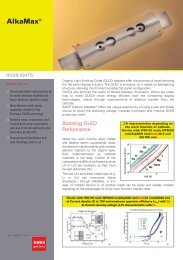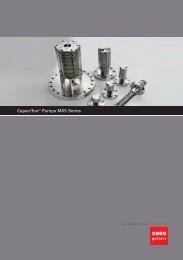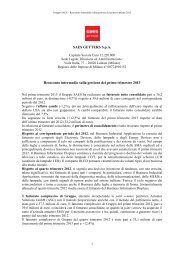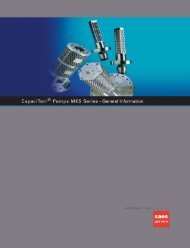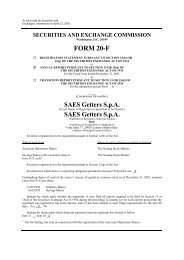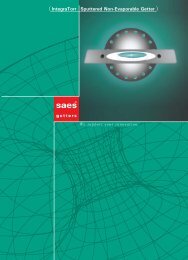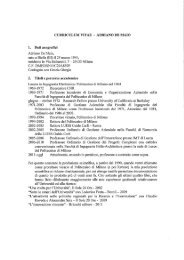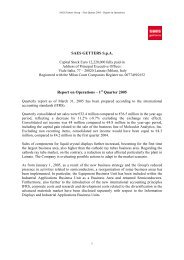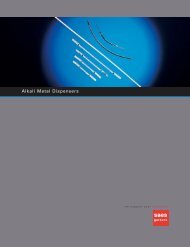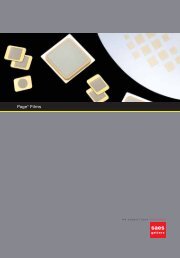sorb ac general.pdf - SAES Getters
sorb ac general.pdf - SAES Getters
sorb ac general.pdf - SAES Getters
- No tags were found...
Create successful ePaper yourself
Turn your PDF publications into a flip-book with our unique Google optimized e-Paper software.
Water Vapor and HydrocarbonsWater vapor and hydrocarbon chemical bonds are cr<strong>ac</strong>ked on the surf<strong>ac</strong>e of the getter material.Hydrogen, oxygen and carbon are then <strong>sorb</strong>ed as explained above. However, sorption efficiency ofhydrocarbons at temperatures under 500°C is very low.Rare GasesGetter materials do not <strong>sorb</strong> rare gases. SORB-AC non-evaporable pumps can therefore be used toremove impurities of <strong>ac</strong>tive gases in rare-gas filled devices.Pumping PerformancesDue to the working principle of getter materials and their typical behavior toward different gas families,the pumping performance (pumping speed and gettering cap<strong>ac</strong>ity) of SORB-AC pumps depends onthe type of gas <strong>sorb</strong>ed and the temperature of the getter cartridge. The pumping performance of SORB-AC pumps are measured <strong>ac</strong>cording to the ASTM standard F798-82, which specifically refers tononevaporable getter devices. The procedure is an application of the dynamic-flow method, also usedfor measurements in other standards. The test is carried out at constant pressure over the getterdevice. It is important to notice that the testing pressure does not affect the pumping speed of thepump when the pressure is below 10 -5 Torr.10000Pumping Speed (I/s)1000H 2 - 25°CH 2 O - 280°CH 2 - 280°CCO - 280°C100H 2 O - 25°CCO - 25°C100.01 0.1 1 10 100 1000Sorbed Quantity (Torr I)Figure 4 - Typical pumping speed curves of a SORB-AC cartridge pumpIn Figure 4, the pumping speed curves of a getter pump for H 2, CO and H 2O are shown. The pumpingspeed value is plotted versus the quantity of gas <strong>sorb</strong>ed during the test. As mentioned above, it wouldbe meaningless and misleading to plot it versus the pressure as in sputter ion pumps. The differentsorption mechanisms of the getter material towards H 2 (high diffusion rate both at high and roomtemperature) and CO (low diffusion rate at room temperature, high diffusion rate at high temperature)are also evident in the curves.The effect of the diffusion phenomena for the sorption of CO is interesting to note. When diffusionis not present, i.e. operating at room temperature, only the surf<strong>ac</strong>e of the getter is available for thesorption of the gas. Therefore the cap<strong>ac</strong>ity is limited and the pumping speed drops to low valueswhen the surf<strong>ac</strong>e becomes saturated. In this case, many re<strong>ac</strong>tivations will be necessary to use thetotal cap<strong>ac</strong>ity of the getter cartridge. When diffusion is present, (i.e. operating at high temperature),the bulk of the getter material is available for gas sorption. The cap<strong>ac</strong>ity for a single <strong>ac</strong>tivation processis much larger and an almost constant value of the pumping speed is maintained for a much longertime. There is not a big difference in sorption performance of H 2 at different operating temperaturesdue to the high diffusivity of this gas even at room temperature, and unlike CO, the cap<strong>ac</strong>ity is reducedwhen operating at high temperature due to the high equilibrium pressure.The sorption of water vapor is preceded by the dissociation of the water molecule on the getter surf<strong>ac</strong>e,and is limited by the cap<strong>ac</strong>ity of the alloy for O 2, while H 2 diffuses quickly into the bulk of the gettermaterial.Oxygen and nitrogen in the bulk diffusion regime are <strong>sorb</strong>ed with pumping speeds of approximately:65% (O 2) and 15% N 2) of the sorption speed of H 2.Hydrocarbons are <strong>sorb</strong>ed only at elevated temperatures and with very low efficiency. A pumpingspeed for CH 4 of about 0.5% of the speed for CO is observed at 500°C.We support your innovation3



